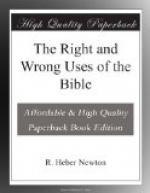That in this fidelity to the tradition of their race the religion of the people of Israel was in the vital processes of growth, through this long period, we know assuredly from one conclusive fact. Out of this tedious winter came, suddenly as it seems to us, a rich and beautiful spring. The epoch of the great prophets, with a new life of thought and aspiration, breaks in abruptly on this commingling of all sorts of religion within the precincts of Jehovahism. Even in February the sap is softening and warming in the veins which show no greening on the tips of the patient trees. Israel was swelling toward the day that was sure to come, when, lo! the spring!
IV.
The era of the great prophets, before the exile: B.C. 800-586.
In the southern Pacific, where coral islands are slowly forming beneath the surface of the sea, he who is curious to study the process of the making of an island must send the divers down to bring up broken bits of coral, snatched from the dark depths in a painful labor. After the ocean mountain thrusts its top above the surface of the sea the work of exploration is easy enough, and we may walk over hard ground as we study the new formation in the sunlight. Hitherto, in our desire to learn the secrets of the growth of Israel, we have been like men peering over the sides of their tiny boats into the depths of a sea that covers fascinating mysteries; watching the labors of the adepts who ever and anon bring up to the light some fresh fragments of a buried world. In the epoch that we have now reached Israel’s growing life lifts itself above the level of tradition, and stands forth as solid history, on whose firm ground we can study for ourselves the making of a nation’s religion.
Israel’s literary period opens for us with the prophets. Literary fragments float up to us from earlier days, but now, for the first time, we have whole books about whose date and authorship we are reasonably certain. The prophets introduced the literary craft. They wrote out, in their later years, the substance of the messages which they had borne the people. These brilliant pages teem with graphic descriptions of the actual usages, social and religious, of their age, so that there is no difficulty in reproducing with fair accuracy the salient features of the period.




